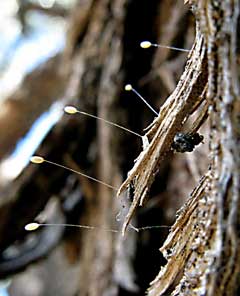
Lacewing eggs on tuart bark
On one of our walks, our walk leader’s sharp eyes spotted the eggs of a lacewing on the bark of a tuart tree – they are very small, and each egg is mounted on a stiff hair that keeps it off the surface. The egg is nearly invisible to the eye, and unlikely to be found by small creatures walking on the bark. The lacewing is better known in its larval form – the ant lion. Ant lions create small conical depressions in the sand in which unwary ants can become trapped, ending up at the bottom of the sandtrap as an ant lion’s supper!



Recent Comments